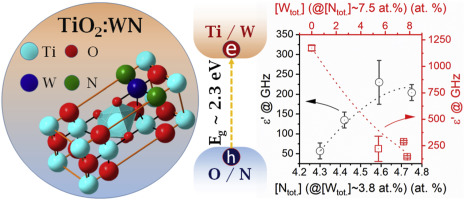当前位置:
X-MOL 学术
›
J. Alloys Compd.
›
论文详情
Our official English website, www.x-mol.net, welcomes your feedback! (Note: you will need to create a separate account there.)
Defect engineering of codoped visible light photosensitized TiO2:WN thin-films for efficient electro-photocatalysis
Journal of Alloys and Compounds ( IF 6.2 ) Pub Date : 2020-08-01 , DOI: 10.1016/j.jallcom.2020.155023 N. Delegan , R. Pandiyan , T. Teranishi , S. Komtchou , A. Dirany , P. Drogui , M.A. El Khakani
Journal of Alloys and Compounds ( IF 6.2 ) Pub Date : 2020-08-01 , DOI: 10.1016/j.jallcom.2020.155023 N. Delegan , R. Pandiyan , T. Teranishi , S. Komtchou , A. Dirany , P. Drogui , M.A. El Khakani

|
Abstract Anionic doping, such as nitrogen doping is widely used to visible-light photosensitize TiO2. Unfortunately, this promotes the formation of oxygen vacancies (VO), reducing the per-photon efficiency of TiO2:N. Herein we propose a solution based on defect engineered acceptor-donor passivation of the electronic defects. This is achieved through the in-situ codoping of TiO2 by both W and N dopants, using an RF-magnetron sputtering deposition process. Compositional and structural analyses revealed that we were successful in incorporating both dopants in substitutional locations in the TiO2 lattice. Where nitrogen doping was confirmed to narrow the Eg of the material from 3.2 eV down to ∼2.3eV regardless of doping scheme. Most importantly, high frequency dielectric spectroscopy revealed that codoping greatly reduced VO concentrations, as tracked by their GHz dielectric contribution. Confirming the passivating interplay between both codopants. Finally, these optoelectronic improvements were shown to directly translate into threefold improved visible-light driven net-photocurrents.
中文翻译:

用于高效电光催化的共掺杂可见光光敏 TiO2:WN 薄膜的缺陷工程
摘要 阴离子掺杂,如氮掺杂被广泛用于可见光光敏化TiO2。不幸的是,这促进了氧空位 (VO) 的形成,降低了 TiO2:N 的每光子效率。在此,我们提出了一种基于电子缺陷的缺陷工程受主-施主钝化的解决方案。这是通过使用射频磁控溅射沉积工艺通过 W 和 N 掺杂剂对 TiO2 进行原位共掺杂来实现的。成分和结构分析表明,我们成功地将两种掺杂剂结合到 TiO2 晶格中的替代位置。无论掺杂方案如何,氮掺杂被证实将材料的 Eg 从 3.2 eV 缩小到~2.3eV。最重要的是,高频介电光谱显示共掺杂大大降低了 VO 浓度,由它们的 GHz 介电贡献跟踪。确认两种共掺杂剂之间的钝化相互作用。最后,这些光电改进被证明可以直接转化为三倍改进的可见光驱动净光电流。
更新日期:2020-08-01
中文翻译:

用于高效电光催化的共掺杂可见光光敏 TiO2:WN 薄膜的缺陷工程
摘要 阴离子掺杂,如氮掺杂被广泛用于可见光光敏化TiO2。不幸的是,这促进了氧空位 (VO) 的形成,降低了 TiO2:N 的每光子效率。在此,我们提出了一种基于电子缺陷的缺陷工程受主-施主钝化的解决方案。这是通过使用射频磁控溅射沉积工艺通过 W 和 N 掺杂剂对 TiO2 进行原位共掺杂来实现的。成分和结构分析表明,我们成功地将两种掺杂剂结合到 TiO2 晶格中的替代位置。无论掺杂方案如何,氮掺杂被证实将材料的 Eg 从 3.2 eV 缩小到~2.3eV。最重要的是,高频介电光谱显示共掺杂大大降低了 VO 浓度,由它们的 GHz 介电贡献跟踪。确认两种共掺杂剂之间的钝化相互作用。最后,这些光电改进被证明可以直接转化为三倍改进的可见光驱动净光电流。



























 京公网安备 11010802027423号
京公网安备 11010802027423号